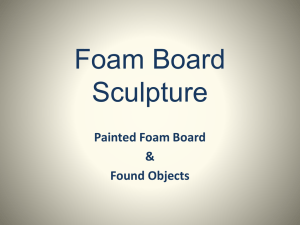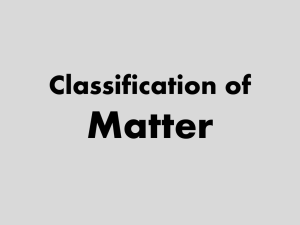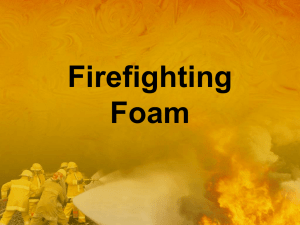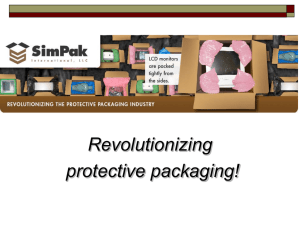Kun Ma_simulation_AI..
advertisement
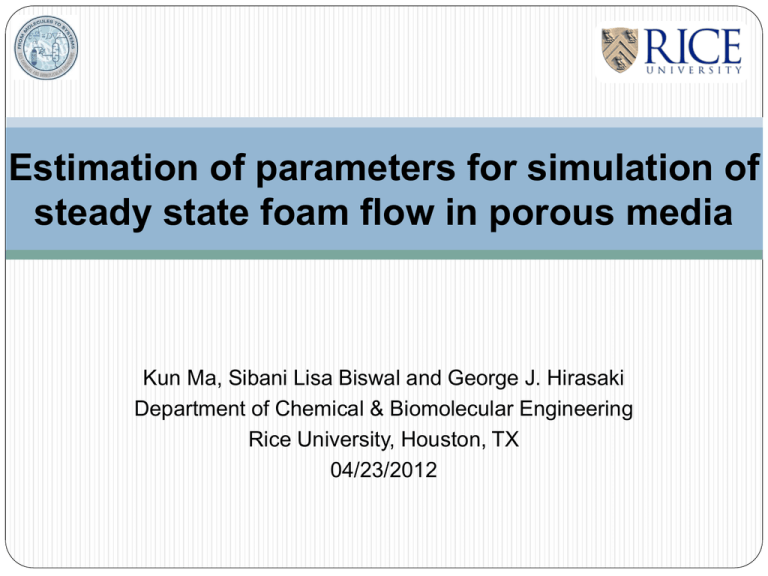
Estimation of parameters for simulation of steady state foam flow in porous media Kun Ma, Sibani Lisa Biswal and George J. Hirasaki Department of Chemical & Biomolecular Engineering Rice University, Houston, TX 04/23/2012 Outline 1. Foam simulators have many parameters. How do we determine them? 2. Compare the experimental results with the foam models in a commercially available reservoir simulator. 3. Develop methodology to describe foam mobility from common foam experiments. Foam in porous media ★ Foam in porous media is defined as a dispersion of gas in liquid such that the liquid phase is continuous and at least some part of the gas phase is made discontinuous by thin liquid films called lamellae1. grains Pore-level schematic of fluid distribution for foam flow2 1. Hirasaki, G. J. (1989). Journal of Petroleum Technology 41(5): 449-456. 2. Radke, C. J. and J. V. Gillis (1990). SPE Annual Technical Conference and Exhibition, 23-26 September 1990, New Orleans, Louisiana. 1-D foam experiments Sandpack: silica sand 20/40 Surfactant: IOS 1518 with 1.0% wt NaCl Length: 27.5 cm R-CH(OH)-CH2-CH(SO3-)-R’ (~75%) R-CH=CH-CH(SO3-)-R’ (~25%), where R+R’ = C12-15 Inner diameter: 2.58 cm Permeability: 158.0 darcy Porosity: 36.0% 1-D foam experiments Total superficial velocity: 20 ft/day foam , app k p uw ug 1-D foam experiments Total superficial velocity: 20 ft/day ug k rg g k ( p g g g D ) k rg k rg FM f FM nf 1 1 fmmob F water F surf gas mobility reduction (1/FM) Foam model Gas mobility is a function of both water saturation and surfactant concentration. 1. 2. Ashoori E, Heijden TLM, Rossen WR (2010) Fractional-Flow Theory of Foam Displacements With Oil. SPE Journal 15:pp. 260-273 Computer Modeling Group (2007) STARSTM User's Guide. Calgary, Alberta, Canada STARS Foam model (old) FM 1 1 fmmob F water F surf F water 0 . 5 Fsurf ( 1. arctan[ epdry ( S w fmdry )] C sw fm surf 1 ) epsurf for C s fm surf for C s fm surf fmmob: the reference foam mobility reduction factor; fmdry: the critical water saturation (volume fraction) above which the maximum foam strength is reached; fmsurf: the critical surfactant concentration above which gas mobility is independent of surfactant concentration. Rossen, W. R. and Renkema, W. J. (2007). Success of Foam SAG Processes in Heterogeneous Reservoirs. SPE Annual Technical Conference and Exhibition. Anaheim, California, U.S.A., Society of Petroleum Engineers. High and low quality regime fg k rg ( S ) / g k rw ( S ) / w k rg ( S ) / g 1 (1 k rg ( S ) / g k rw ( S ) / w S w S w fmdry * f 1. 2. 1 (1 1 ? k rg ( S w ) FM ( S w ) nf * g ) * * * k rw ( S w ) w g ) 1 Cheng, L., Reme, A. B., et al. (2000). Simulating Foam Processes at High and Low Foam Qualities. SPE/DOE Improved Oil Recovery Symposium. Tulsa, Oklahoma. Alvarez, J. M., Rivas, H. J., et al. (2001). Unified Model for Steady-State Foam Behavior at High and Low Foam Qualities. SPE Journal 6(3). Sw* and fmdry An example using fmmob = 12000 and fmdry = 0.34: 1. Sw* is close but not equal to fmdry; 2 . Sw* can be calculated through max foam , app ( S w ) foam , app ( S w ) * Sw*=0.3461 fmdry=0.3400 Sw* and fmdry An example using fmmob = 12000 and fmdry = 0.34: fg-Sw curve is very steep near Sw* and precise calculation of Sw* is needed. Sw*=0.3461 fg* fmdry=0.3400 The problem to solve Solve fmmob, fmdry and Sw* through the following equations: * foam , app 1 ( measured ) f * k rw ( S w ) w g 1 f g ( measured ) * g * 1 k rw ( S w ) w f * 1 k rw ( S w ) w f * k rg ( S w , fmmob , fmdry ) max foam , app ( S w ) foam , app ( S w ) foam , app ( S w ) * k rg ( S w , fmmob , fmdry ) k rg ( S w ) g Using Equations (a) and (b) to determine a contour plot 1 of fg* as a function of fmmob and fmdry max foam , app ( S w ) foam , app ( S w ) * Eqn (a) Using Equations (c) and (d) to determine a contour plot 2 of μfoam,app as a function of fmmob and fmdry 1 f g , measured * 1 1 fg * 1 * w k rw ( S ) w Eqn (b) g f rg * w k (S ) foam , app (S w ) k rw ( S w ) w g f k rg ( S w ) 1 k rw ( S w ) w Eqn (c) Eqn (d) f Perform superposition of contour plots 1 and 2 and indentify the point (fmmob, fmdry) where fg*= fg,measured* in contour plot 1 and μfoam,app= μfoam, measured* in contour plot 2 cross over k rg ( S w ) g Match experimental data fg=0.5 Computed from: Computed from: 1 fg * g * 1 k rw ( S w ) w f * k rg ( S w ) foam , app (S w ) 1 k rw ( S w ) w f k rg ( S w ) g Match experimental data Match experimental data Total superficial velocity: 20 ft/day fmmob=26800 fmdry=0.311 Dependence on surfactant concentration Revised Foam model (new) FM 1 1 fmmob F water F surf arctan[ epdry ( S w fmdry ( F water 0 . 5 F surf C sw epsurf ) ( fmsurf 1 C sw fmsurf for C sw fmsurf for C sw fmsurf instead of fmdry in the old model ) epfmdry )] Surface tension fmsurf (hypothesized) Match experimental data Conclusions 1. A new method of fitting the parameters in the STARS foam model is presented and a unique group of parameters is found for modeling the foam property in silica sandpack with the surfactant 0.02%-0.2% IOS 1518 in 1.0% NaCl solution. 2. A revised model for effect of surfactant concentration is proposed. 3.The critical surfactant concentration (fmsurf) in the foam model is at least one order of magnitude above the CMC. Acknowledgment This work was financially supported by ADNOC, ADCO, ZADCO, ADMA-OPCO and PI, U.A.E. Thank you! Parameters for foam simulation

